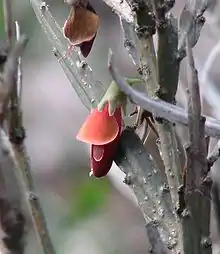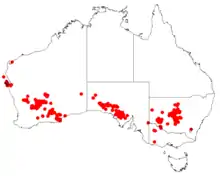Bossiaea walkeri
Bossiaea walkeri, also known as cactus bossiaea or cactus pea, is a species of flowering plant in the pea family (Fabaceae). It is a leafless shrub that grows to between 0.5 and 2.5 metres high. Flowers are produced between July and November in the species' native range.[1] It occurs in Western Australia, South Australia, Victoria and New South Wales. Bossiaea gets its name from the French physician, biologist, and botanist Joseph Hughes Boissieu Martiniere (1758-1788). Walkeri is named after Alex Walker, who first collected this type of specimen from the Peel Range in New South Wales.[2]
| Cactus bossiaea | |
|---|---|
 | |
| Bossiaea walkeri | |
| Scientific classification | |
| Kingdom: | |
| Phylum: | |
| Class: | |
| Order: | |
| Family: | |
| Genus: | |
| Species: | B. walkeri |
| Binomial name | |
| Bossiaea walkeri | |
 | |
| Occurrence data from AVH | |
Description
Bossiaea walkeri is a shrub with tangled branches that grow roughly 2m by 2m, giving the shrub a round appearance.[3] The Bossiaea walkeri leaves are reduced to tiny scales and are about 2mm long. What looks like waxy green leaves on the branches are actually cladodes. Cladodes have a similar function to leaves, they perform photosynthesis, respiration, and transpiration. But they are more hardy than leaves, they reduce water loss and there isn't the need to replace fallen leaves.[4]
It has 2cm pink, orange, and red pea-flowers that are produced between July and November. The flower's standard is much shorter than the wings and keel.[5] The standard ranges between 13-17mm long, it is smooth and not auriculate, the wings are 15-16mm long, and the keel is 20-21mm long, smooth and not auriculate.[6]
Taxonomy
The genus Bossiaea is endemic to Australia and comprises 101 species. Morphological features of Bossiaea include: the stamens are close together and face towards the stem of the plant, anthers are dorsifixed and are the same size, and the seeds have a distinctively lobed aril.[7] Standard and wing petals are mostly yellow, but red markings are also common.
- Kingdom: Plantae
- Phylum: Tracheophyta
- Class: Magnoliopsida
- Order: Fabales
- Family: Fabaceae
Geographic range
Bossiaea walkeri is endemic to Australia and grows in all states except Northern Territory.[3] In South Australia it is found in the northern part of the Eyre Peninsula in mallee woodland in red sandy soils.[9] It is frequently found in mallee woodland in Central and South-West New South Wales, and inland Western Australia. However, it is listed as endangered in Victoria.[3] It is also known to grow in clay, limestone, and yellow sand, and is the only species of Bossiaea to occupy arid regions.[7]
Reproduction
The 2cm flowers are produced between July and November. They will often flower after seed has set to take full advantage of additional rainfall after a dry period.[4] The fruit is a hairless, flattened 6cm by 1cm pod that contains brown seeds. The pods begin green but mature to brown, the seeds become ripe usually 2 to 3 months after flowering has finished.[3] Then on a hot day the pods will explode to disperse the seed several metres. Birds are the primary pollinators, but small animals and insects also contribute.[4]
Bossiaea walkeri produces a very distinct honey, although it appears to have no pastoral value.[3]
References
- "Bossiaea walkeri". FloraBase. Western Australian Government Department of Parks and Wildlife.
- "Seeds of South Australia - Species Information". spapps.environment.sa.gov.au. Retrieved 24 October 2020.
- Australian National Botanic Gardens, Parks Australia. "Bossiaea walkeri - Growing Native Plants". www.anbg.gov.au. Retrieved 25 October 2020.
- Archer, William (30 January 2010). "Esperance Wildflowers: Cactus Pea - Bossiaea walkeri". Esperance Wildflowers. Retrieved 25 October 2020.
- Corrick, Margaret G.; Fuhrer, Bruce Alexander (2009). Wildflowers of Southern Western Australia. Rosenberg Pub. ISBN 978-1-877058-84-4.
- Western Australian Herbarium, Biodiversity and Conservation Science. "FloraBase—the Western Australian Flora". florabase.dpaw.wa.gov.au. Retrieved 25 October 2020.
- Thompson, Ian (2012). "A revision of eastern Asutalian Bossiaea" (PDF).
- "Flora of Victoria". vicflora.rbg.vic.gov.au. Retrieved 25 October 2020.
- "Seeds of South Australia - Species Information". spapps.environment.sa.gov.au. Retrieved 26 October 2020.
- T. A. James. "New South Wales Flora Online: Bossiaea walkeri". Royal Botanic Gardens & Domain Trust, Sydney, Australia.
External links
- "Bossiaea walkeri". Australian Plant Name Index (APNI), IBIS database. Centre for Plant Biodiversity Research, Australian Government.